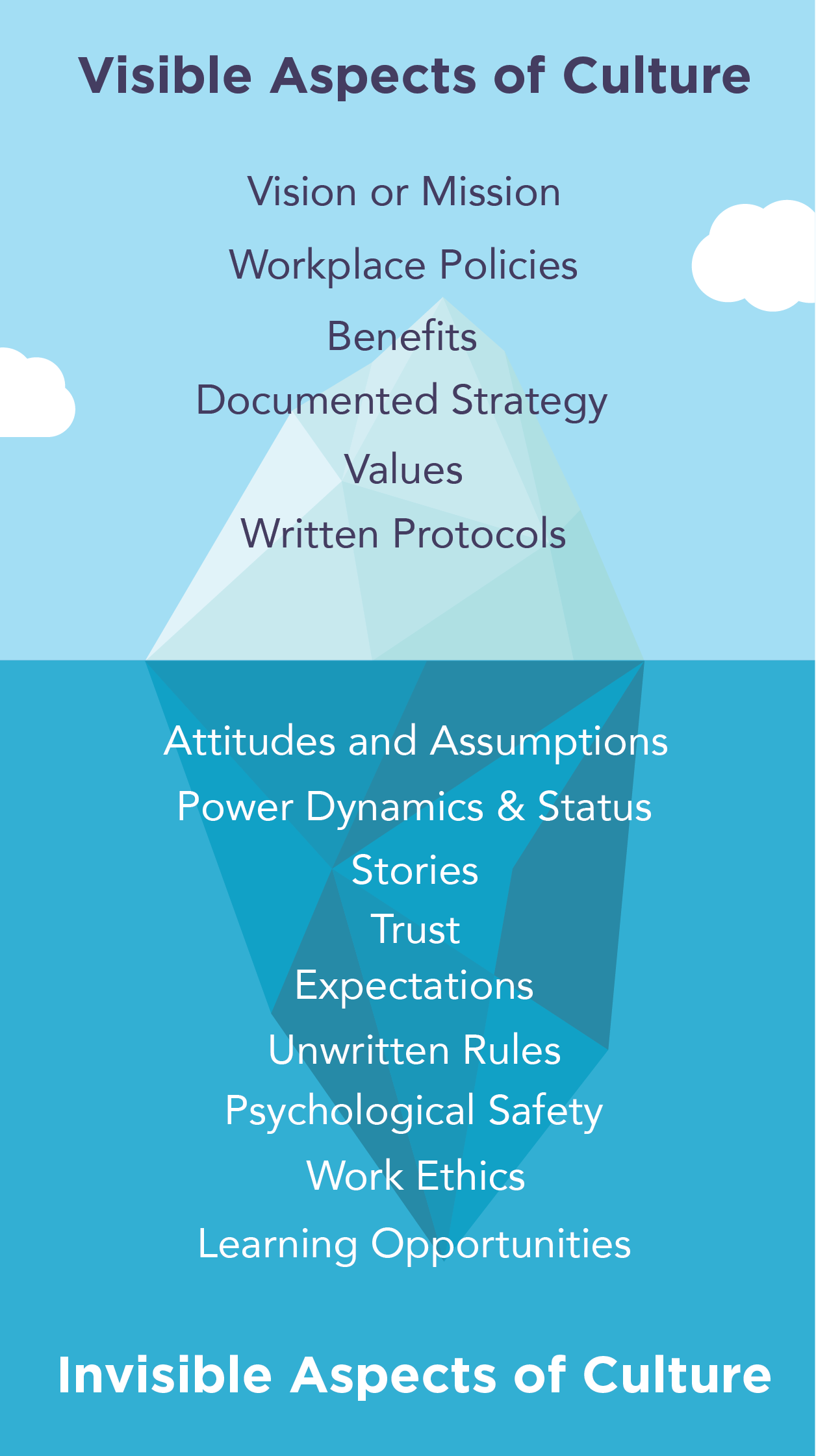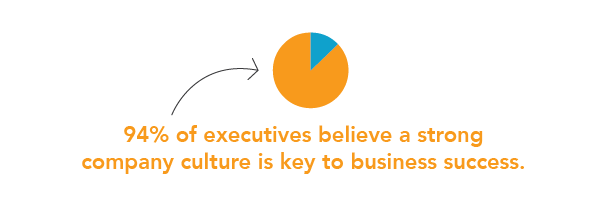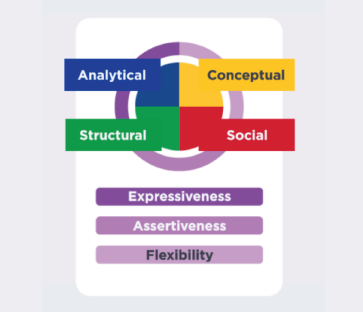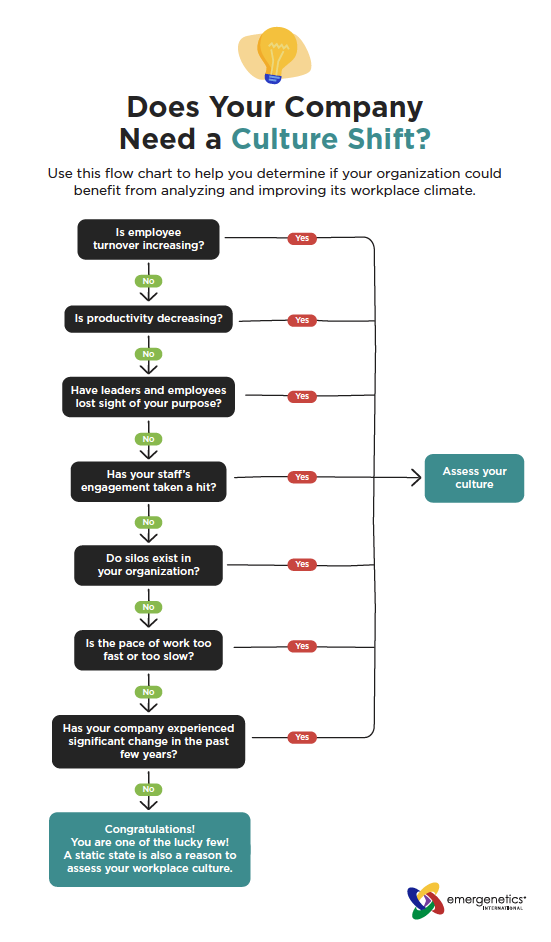Setting the Foundation for an Inspired Business Strategy
No two companies will ever have the same culture. Even if businesses are in the same industry, share a similar set of core values and are focused on similar drivers of corporate culture, the ways that their work environment comes to life will inherently have nuances because the people, experiences and practices that make up each company will be unique.

That is why a strong workplace culture can truly be a competitive advantage for companies, or if leaders are not careful, a disadvantage.
To create a positive culture that inspires employees to do their best work, executives, Human Resources leaders and managers play an important role in articulating the story of how business gets done as well as walking the talk and modeling behavior for others.
The Definition of Workplace Culture
There are many ways to explain this concept. One popular definition for an organization’s culture comes from Great Place to Work, which describes it as:
How you do what you do in the workplace. It’s the sum of your formal and informal systems and behaviors and values, all of which create an experience for your employees and customers.
Some of the elements that make up the formal systems include:
- The mission statement and stated values
- Written protocols around the usage of communication systems, social media, etc.
- Policies regarding topics like performance management and diversity and inclusion
- Rituals and company traditions
- Workplace benefits
Informal systems take into consideration:
- Underlying attitudes and assumptions that guide behavior
- How different functions and people interact and communicate with one another
- The way employees feel at work
- Influence and power dynamics between individuals and groups
- The stories that are told

Another helpful way to consider culture is through the lens of an iceberg. The formal systems and mechanisms of culture tend to be quite visible. They are written down, codified and shared while onboarding new talent or on company websites as part of a business’s employer brand identity. The other part of culture comes below the surface. It’s made up of all the informal, unwritten rules and systems that guide the way people operate within the business.
Ideally, there is alignment between the formal, informal, visible and invisible elements of culture. When there is a direct connection, employees tend to be clear on the best ways to interact and get their work done. When there is no alignment, confusion often arises, especially for new workers, and employees may get jaded from differing stated and unstated expectations and norms.
The Importance of Workplace Culture
Most employers understand the negative impacts of a toxic culture. These sorts of work environments often increase burnout, drain employee well-being and decrease employee engagement. Ultimately, such cultures lead to increased employee turnover as well as decreased productivity and poor performance for individuals and the company overall.
In comparison, a positive workplace culture has a significant influence on the organization through:
- Employee impact
- Business performance
- Hiring
Employee Impact
77% of employees state that working in a strong company culture helps them do their best work with 76% reporting that a positive culture supports their productivity and efficiency. There is also a significant correlation between a great work environment and high employee engagement, which results in lower turnover.

Business Performance
88% of employees and 94% of executives believe a strong company culture is key to business success, and the data proves them right. In addition to having more productive and motivated employees, engaging workplace cultures also tend to have higher levels of innovation (by about 30%) and increased revenue growth.

Hiring
46% of job seekers cite organizational culture as very important when choosing to apply to a company, and 35% say they would pass on the perfect job if the company’s culture wasn’t a good fit. To attract top talent, it’s crucial to put time and energy into creating positive workplace cultures. In addition to boosting recruitment practices, sharing your culture will help to attract even better job candidates because people are likely to select future roles based on cultural fit.
With all these benefits, it’s no wonder that the adage culture eats strategy for breakfast remains a popular one!
The Cultural Revolutions Motivating Cultural Change
While creating a positive workplace culture has been a topic of conversation for years, it is growing increasingly important considering several shifts.
Generational Changes
From a generational perspective, company culture is vital to millennials and Gen Z. Compared with prior age groups, workers from these generations tend to prioritize culture and value having a strong sense of purpose at work above a paycheck. While compensation certainly has a significant impact on hiring, younger staff are increasingly looking to join companies where work-life balance is prioritized, employees have a voice and people are trusted to operate with autonomy. Businesses that fail to provide an engaging, flexible work environment are unlikely to attract new talent.
It's important to note that, while millennials and Gen Z may receive more attention for their desire for a strong culture, they are not the only ones. 92% of employees say that culture has an impact on their decision to remain with an employer. While younger generations may be the most vocal, work conditions matter to everyone.
Mindset Shifts
2020 and the resulting challenges from the pandemic caused many individuals to reevaluate what mattered most to them. Through these evolving attitudes and mindsets came the Great Resignation, and the strongest predictor of attrition has been a toxic culture. Employees are looking for a workplace environment where they will be appreciated, heard and have opportunities to grow, so an unhealthy culture will no longer be tolerated.
On the heels of the Great Resignation came the trend of quiet quitting. Most staff members who take part in quiet quitting are doing so because of burnout and an unreasonable workload. Rather than continuing to take on more for the business, employees are choosing to focus on the basics and disengage from additional work. As this trend continues, leaders should take it as a sign to evaluate their work culture to look for indications of unhealthy expectations.
The Factors Impacting Organizational Culture
The employee experience is affected by many elements, which is why there is such a variety of work environments around the world. Below are some of the core factors that can contribute to or take away from a positive workplace culture.
People
At the heart of a company culture lies the individuals who are part of it. Leadership teams and managers often have the most influence over how the workplace culture is lived; however, the environment may also be influenced by the different personalities, personal values, beliefs and experiences of the people who are hired. For better or worse, each person can impact the corporate ethos.
Core Values & Philosophies
While a company’s values are often clearly stated, the philosophies that support or hinder these defined practices may not be so openly defined. The beliefs and tenets that individuals bring to the organization, and how those philosophies are lived, can affect the company culture that is created.
Hierarchy
Most companies have an organizational structure, which may be highly formal or take more of a network approach. The value different team members and the business put on a hierarchical culture versus an adhocracy culture or anywhere in between will have an effect on the attitudes of employees and how they behave and interact with one another.
Subcultures
Often, as businesses grow, teams, departments and divisions may start to develop their own practices, rituals and norms. The actions can certainly contribute to a positive workplace culture, or they may cause confusion and diminish the work culture if they run counter to the beliefs and tenets of the organization.
Location
The rise of the hybrid workplace has certainly influenced culture. The most obvious impact has been on the workplace environment itself with many employees working remotely. The shift in employee geography has necessitated a transformation in the formal and informal systems that companies use to communicate, collaborate and coordinate.
The Core Elements of a Positive Workplace Culture
To support a successful business strategy, start by focusing on nine essential ingredients of an engaging organizational culture.
Driving Purpose in the Workplace
Creating a common vision and a sense of shared values with employees will inspire a positive work culture. To cultivate an engaging climate, employers must be mindful that their purpose statement needs to focus on more than money. It should motivate, inspire and serve to align employees.
Instilling a Sense of Belonging
Individual differences can be a source of strength for companies. After all, diversity of thought increases innovation, problem-solving and productivity. When businesses create a space where they truly encourage employees to be themselves, train staff to release unconscious bias and welcome all elements of a diverse population including cognitive differences, race, gender and sexual orientation, the culture and its people will benefit.
Providing Holistic Benefits
Taking a comprehensive view of wellness will propel stronger cultures. As employee expectations are shifting, workers are looking for fair compensation as well as holistic benefits that support their physical, mental, emotional, social and financial needs. By honoring the whole person, companies will realize a positive return in their workplace culture.
Curating Communication to Support Workplace Culture
Providing employees with regular communication from the leadership team and empowering managers to provide transparent updates about the business will promote a positive workplace culture. It’s also essential to offer feedback loops that promote employee voice. When staff can share challenges and inputs, they feel more engaged and businesses benefit from new ideas.
Amplifying Recognition
Everyone in the workforce appreciates feeling valued and celebrated. That is why many employers are investing in recognition programs, designed to acknowledge the great work their people are doing. By celebrating milestones with big and small ways to say thank you, employees feel a sense of accomplishment and companies often see lower turnover.
Cultivating Meaningful Connection
Building strong relationships is vital to a positive workplace culture. A sense of community encourages people to come forward if they have challenges or feel uncomfortable. It promotes better output and performance by allowing staff to collaborate effectively. It also makes work more fun! Make time for small check in’s and regular team building.
Supporting Employee Development
According to LinkedIn, opportunities to learn and grow are the #1 driver of a great culture. Employees want to develop new skills, make progress in their careers and continue to gain new knowledge. When companies invest in their people, they will see improvements in their work environment through better performance and happier employees.
Increasing Autonomy to Encourage Work Life Balance
Personnel want to feel empowered to do their work and make a meaningful contribution to the organization. While some businesses have recently turned toward tech companies that monitor clicks on a computer and engage in other extreme corporate oversight, forward-thinking employers will instead focus on how they can train staff to maximize productivity while honoring their work-life balance and expertise.
Promoting a Culture of Compassion
When employers do all of the above, it will demonstrate that they value employees. There is also one more dimension that is critical to positive workplace cultures: compassion. When personnel believe that the leadership team and their managers truly care about them as individuals, it will encourage loyalty and help them do their best work.
Want specific strategies to create a stronger work culture?
A Look at Company Culture through the Emergenetics Attributes

Emergenetics provides another lens to understand what people will likely want from their workplace culture. Each person will have their own preferences for the ways they prefer to think and behave. These tendencies have a direct impact on the sorts of experiences and priorities they appreciate most in a workplace environment.
Thinking Attributes
Analytical
This Attribute typically prioritizes the bottom line. When designing your work culture, it’s useful to describe the value they will get from being part of the business whether that comes from building their expertise, improved benefits or something that speaks to their value system.
Structural
Structural Thinking is often associated with an interest in order. This does not mean they are necessarily drawn to a hierarchy culture. Instead, individuals with this preference are likely to be engaged in a work culture where expectations are clear and achievable, and where accountability is valued, regardless of the organizational structure.
Social
This Attribute typically focuses on the people aspect of business. They are likely to feel energized in a workplace culture where individuals are cared for and have an opportunity to build strong relationships with one another.
Conceptual
The Conceptual Attribute often feels a connection to big-picture ideas. A positive culture through this lens would include a compelling vision that is long-term in nature and a chance to experiment in their work.
Behavioral Attributes
Expressiveness
Expressiveness describes how people prefer to share their thoughts and feelings. Some tend to be talkative while others are more introspective. To create supportive work environments, consider how individuals are given a chance to share their ideas, inputs and challenges through a multitude of channels.
Assertiveness
This Attribute reflects the style and pace with which people prefer to advance their thoughts and beliefs. Certain employees may prefer a forceful approach, while others may tend toward keeping the peace. Leaders can evaluate what sort of work culture they are promoting by being mindful of developing norms that allow both sides of this spectrum to flourish.
Flexibility
Flexibility explains the way that individuals react to imposed change. Some innately prefer to keep options open while others like to stay the course. Consider your workplace environment through this perspective by reflecting on its attitude toward adhocracy culture, shifts in the market and how the business evaluates and incorporates recommendations from employees.
The People Who Drive Workplace Culture
Every person has an impact on the way that a company’s ethos comes to life, so it’s important to understand the different mechanisms each group can focus on to encourage a positive work culture.

The Role of Human Resources
HR often serves as the stewards of workplace culture. They play a crucial role in operationalizing the values and ethos with transparent policy, creating the sorts of rewards and recognition structures that inspire employee engagement as well as designing the performance management systems that help ensure individuals are upholding the tenets of the business.
The Role of Learning & Development
To reiterate this statistic, opportunities to grow and learn are the #1 driver of company culture. Investing in programs to support professional development demonstrates that an organization values its staff. By taking time to understand training needs and building engaging programming, L&D will play an incredibly important part in supporting a positive workplace culture.
The Role of Executives
As leadership teams define the strategic direction of the company, culture should be a core factor in their considerations. Executives not only need to model the behaviors they want to see, they must also demonstrate how the culture and values impact decision-making at the highest level.
The Role of Managers
Supervisors have a significant impact on strong workplace cultures. They are the ones who bring the strategic direction as well as HR and L&D policies to life for individual teams. They also spend the most time with individual employees. They must have the training and tools to live and breathe the company culture.
The Role of Employees
If all of the individuals above are embodying the business’s culture, employees will have an easier time doing so themselves. That said, they also affect one another. Provide staff with resources to participate in as well as influence the workplace culture through traditions, recognition programs, committees and more.
When to Assess a Company’s Culture
What opportunities do you see for improvement when you think about your current culture? Perhaps some obvious fixes come to mind based on the culture considerations listed above, or maybe you’re not quite sure what, if any, adjustments need to be made to improve the status quo.
To identify if it’s time to initiate change, consider these questions:
- Is employee turnover increasing?
- Is productivity decreasing?
- Have leaders or employees lost sight of the organization’s purpose?
- Has employee engagement taken a hit?
- Do silos exist in your organization?
- Is the pace of work too fast or too slow?
- Has your company experienced significant change in the past few years?
If you answered “yes,” to any of those questions, it’s probably a good time to assess your current culture. If you answered “no” to each of the questions above, particularly the one around change, it may be worth examining whether your culture is too risk averse as that can be another reason to examine your environment.
You may also want to get a second opinion on these questions, so please copy and share the image of the flowchart below with anyone else in your company whose inputs you may want.

While it may feel overwhelming to reassess the business’s work culture, it can be helpful to start by pinpointing a few opportunities for improvement. Take time to connect with staff and leaders to analyze how your company is doing on the nine essential elements of company culture:
-
1. Purpose
2. Belonging
3. Benefits
4. Communication
5. Recognition
6. Connection
7. Growth
8. Autonomy
9. Compassion
In a simple survey, executives, managers and staff can evaluate the workplace culture elements on a Likert scale. Through this short assessment, you can identify areas that are sources of strength for your workplace culture as well as opportunities for improvement. You may also find that certain audiences rate each category differently. These insights are equally important as they may illuminate discrepancies in how effectively your business is living its ethos.

Create a Positive Culture for Your People Using Emergenetics
Another way to get started on building a new culture for your company is to partner with the Emergenetics International team. We specialize in creating a positive workplace for businesses, nonprofits, educational institutions and government entities. Through the Language of Grace and our programming, we transform cultures to foster psychological safety, appreciation and productivity.
Language of Grace
At Emergenetics, we believe in the power of strengths-based language, or what we call the Language of Grace. This practice focuses on using vocabulary with positive connotations, and it can have ripple effects throughout an organization.
Numerous studies have shown the health-related benefits of positive thinking, including an increased life span and better physical and psychological well-being. In addition to the positive feeling that a person may experience with affirming vocabulary, it has also been shown to improve motivation and performance.
The Language of Grace is woven into Emergenetics through our reports, essential workshops and digital coursework, and it can spark a motivating shift in your work culture.
Emergenetics Programming
To bolster a positive workplace culture, our essential workshops allow employees to take the Emergenetics Profile and participate in a fun, engaging workshop to learn about:
- The Thinking and Behavioral preferences of themselves and their colleagues,
- The brilliances that come from each of these Attributes,
- The power of cognitive diversity and
- The language of grace
Participants also gain access to the Emergenetics+ mobile app that provides them with the following resources to promote welcoming workplace cultures:
- Connections, where employees can discover tips to improve communication and collaboration with colleagues who also have Emergenetics Profiles
- Saved Groups, which provide insights into team dynamics and strategies to work together productively
- Attributes in Action Guides, which describe how individuals can use the Emergenetics Attributes to navigate common workplace challenges like conflict resolution, problem-solving, goal setting and more

These tips empower people to connect in a way that honors each person for being exactly who they are, promoting a sense of belonging, positive communication and strong workplace relationships. Businesses can build on this learning in several ways, including team-based workshops or our suite of digital learning solutions.
Our train-the-trainer model also provides HR, L&D and OD professionals with the tools to deliver Emergenetics programming, integrate Thinking and Behavioral insights into their learning and development offerings and apply the Language of Grace in their own programming.


